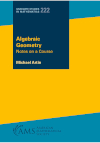- About MAA
- Membership
- MAA Publications
- Periodicals
- Blogs
- MAA Book Series
- MAA Press (an imprint of the AMS)
- MAA Notes
- MAA Reviews
- Mathematical Communication
- Information for Libraries
- Author Resources
- Advertise with MAA
- Meetings
- Competitions
- Programs
- Communities
- MAA Sections
- SIGMAA
- MAA Connect
- Students
- MAA Awards
- Awards Booklets
- Writing Awards
- Teaching Awards
- Service Awards
- Research Awards
- Lecture Awards
- Putnam Competition Individual and Team Winners
- D. E. Shaw Group AMC 8 Awards & Certificates
- Maryam Mirzakhani AMC 10 A Awards & Certificates
- Two Sigma AMC 10 B Awards & Certificates
- Jane Street AMC 12 A Awards & Certificates
- Akamai AMC 12 B Awards & Certificates
- High School Teachers
- News
You are here
Algebraic Geometry: Notes on a Course

Buy Now:
Publisher:
AMS
Publication Date:
2023
Number of Pages:
222
Format:
Paperback
Series:
Graduate Studies in Mathematics
Price:
85.00
ISBN:
978-1-4704-7111-8
Category:
Textbook
[Reviewed by , on ]
David Murphy
10/8/2023
The importance of algebraic geometry is reflected by the number of textbooks available on the subject, to which Michael Artin’s new book, Algebraic Geometry—Notes on a Course, is a worthy addition. By restricting attention to affine and projective varieties over \( \mathbb{C} \), it develops many of the major tools with reasonable sacrifices in its generality. Without schemes or sheaf theory, it treats \( \mathcal{O}\)-modules and their cohomology with applications including intersection multiplicity and Bézout’s Theorem, the Riemann-Roch Theorem and curves of
low genus.
These topics are also covered in Fulton’s Algebraic Curves. In that text, for comparison, intersection numbers are defined axiomatically and spaces associated to divisors for Riemann-Roch are described as vector spaces. Such tools are developed with the corresponding theorems as their objectives and the text builds to these results (among others). In contrast, Artin integrates these tools and theorems within his larger narrative, the development of \( \mathcal{O} \)-modules and their cohomology. As a result, these key theorems fit into a unified story of algebraic geometry, where \( \mathcal{O} \)-modules and cohomology are essential and explanatory components. This makes Artin’s text algebraically more demanding than Fulton’s book, but it is not as demanding as many standard texts.
Abstract algebraic geometry presents the challenge of including and incorporating “the vast amount of purely algebraic material which is needed” that led Zariski and Samuel to write their two-volume text on commutative algebra (reviewed here and here) and Eisenbud to write a nearly 800-page text on commutative algebra subtitled with a View toward Algebraic Geometry. This creates a significant hurdle to students, so that it can take a year-and-a-half of graduate courses before one is ready to study Hartshorne’s text, and it can take more than a semester to cover its content from varieties through cohomology. This was my experience.
In contrast, Artin’s goal is “to get to cohomology of \( \mathcal{O} \)-modules . . . in one semester, without presupposing a knowledge of sheaf theory or of much commutative algebra” (p ix). Along the way, he covers the standard topics of plane curves (chapter 1), affine and projective varieties (chapters 2 and 3), integral morphisms (chapter 4), and the structure of varieties in the Zariski topology (chapter 5). This overlaps with the material of chapter I in Hartshorne, but Artin adds interesting special topics: finite group actions, lines in three-space, and lines on a cubic surface. Additionally, as a benefit of working over \( \mathbb{C}\), he compares constructible sets and constant coefficient cohomologies in the classical and Zariski topologies, as well as the classical topology of smooth projective curves and branched coverings.
While the amount of algebra and topology required to follow this text is less than that of several of its peers, it is greater than what typically is covered in introductory undergraduate courses. Thus the book includes an essential final chapter (chapter 9) that fills some gaps for its readers. Even with this chapter, Artin’s text demands an exceptional undergraduate student to study it from cover to cover. For this reason, it is best suited for a graduate course.
Overall, Artin’s text offers an excellent graduate-level introductory course in algebraic geometry. It covers the core topics from varieties to cohomology as a one-semester course that can be taken without a prior class in commutative algebra. Artin shares valuable insights of what is essential to algebraic geometry and where one should focus to appreciate the bigger picture and cautions the reader of technical pitfalls and points of confusion. He provides motivation and well-chosen examples that train the readers’ intuition. Moreover, the style is personal and inviting, like a professor talking with students. The book offers the chance to be his student, an experience I enjoyed and learned from by reading Algebraic Geometry—Notes on a Course.
David Murphy is Professor of Mathematics at Hillsdale College in Michigan. His area of expertise is algebraic geometry.
See the publisher's website.
- Log in to post comments




